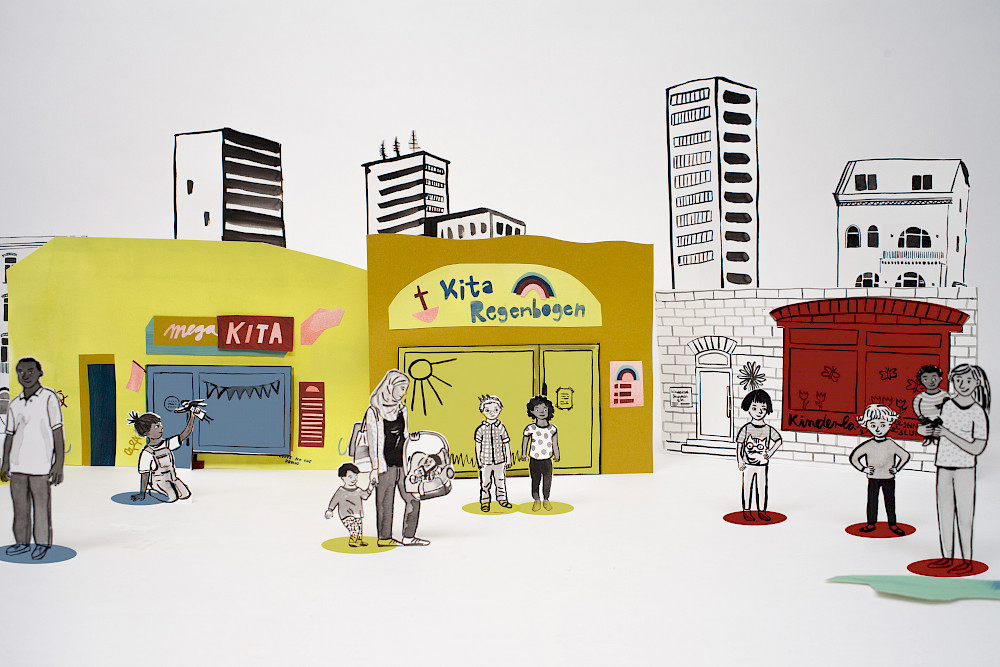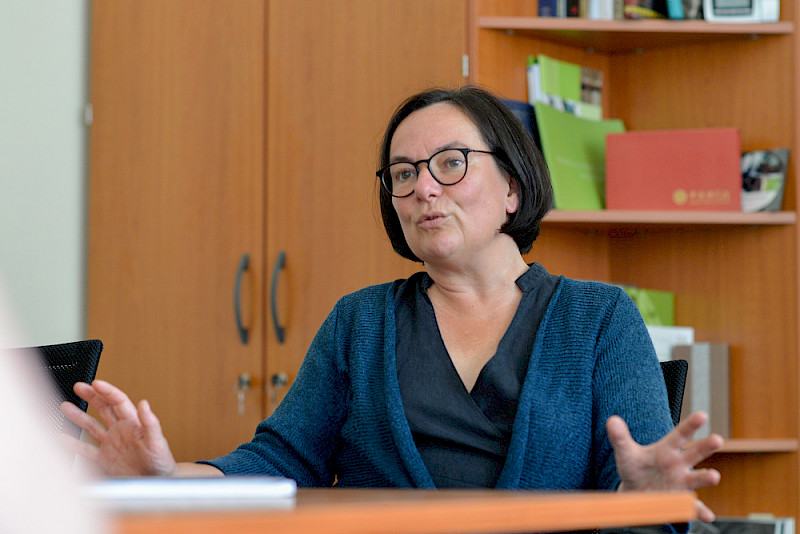“Social cohesion begins in the daycare centre”

You and a team of researchers from Halle and Hamburg are investigating social and ethnic segregation in daycare centres, in other words, if and where children from specific populations tend to remain in their own isolated groups. Before we begin: What would the ideal daycare centre look like to you?
Johanna Mierendorff: It would reflect the social and cultural make-up of the neighbourhood in which it is located so that children from different living environments, cultures, religions, education levels, income brackets and family types would “experience” life together from the very beginning. But, of course, we have cities where the neighbourhoods themselves are already very segregated ...
So, should a daycare centre, for example in Halle-Neustadt, a neighbourhood with a high proportion of child poverty and people with a migration background, only reflect the Halle-Neustadt neighbourhood?
That is a difficult question to answer. I believe that if you want to take a child’s living environment seriously, there is no other way. In the US, there is busing, where children are moved from one neighbourhood to another to create something like diversity. This is very difficult from the perspective of the child, who then has to travel further distances - and from the perspective of the everyday life of the parents. Highly segregated neighbourhoods are not only a question of the education system, but of urban planning and urban development.
Why do you believe social mix and inclusion is so important?
I believe it is a better approach from an education and civil society standpoint. Early segregation and differentiation from others mean that you constantly remain in your bubble. Another point: there are known to be fewer support opportunities for disadvantaged children in segregated settings where many children with challenges of whatever kind converge. For me, it is also a question of solidarity. In integrated groups, children who have, for example, language difficulties are carried along. They benefit from peers who are at a different level.
... without it being at the expense of providing support for the other children?
It is a question of how daily life is pedagogically designed. I don’t believe that, in such a situation, children necessarily have to be bored just because they are smarter. They also benefit on several levels: by getting to know different cultures, learning patience in dealing with different people and different abilities, and through solidarity. Social cohesion does not begin with policies or the labour market. It begins in daycare centres.
In your research project, you investigated the extent of segregation and the role that daycare centres and providers play. Has nothing like this been investigated before?
Research of this kind is new. So far, studies have mainly found that the different compositions of daycare centres are mainly due to the parents’ voting habits. We believe that this is only one aspect in the process. We also wanted to find out how the allocation of daycare spots is connected to the daycare provider. In her post-doctoral thesis written in Münster, my colleague Nina Hogrebe found that the daycare centres in one neighbourhood of a large West German city varied widely in terms of composition. Centres run by parent initiatives and Catholic institutions had virtually no groups of children that were integrated in terms of social status and migration background, while the daycare centres run by the Arbeiterwohlfahrt (Workers’ Welfare Association) and the municipality were very integrated. We wanted to see whether this can be transferred to Germany as a whole - East and West, urban and rural. We found that this is not true across the board. For example, with the exception of parent initiatives, no other providers could be identified whose daycares had a particularly large or small number of children from certain population groups.
That means?
That the question of segregation is not about specific providers, but about regional contexts, each embedded in a specific structure. What we have seen is that there are segregation processes everywhere in urban areas - even more so in childcare than in the surrounding communities. Even in neighbourhoods where inclusion would be possible, we see great variation: from daycares where 99 per cent of the children have a migration background or are on social benefits, to those where none of these social characteristics apply to the children. Therefore, we looked at how cooperation between the providers, the institutions themselves and, one level up, the youth welfare agency can lead to such segregation.
What did you find?
That this problem is rarely discussed or debated. For one thing, the youth welfare agencies have a great interest in ensuring that all children receive a daycare spot in line with their legal entitlement to childcare. The daycare providers also tend to disregard the problem. It has become clear that the heads of the daycare centres, who tend look at things from the perspective of their own facility, are almost solely responsible for selecting the child to fill the spot. This means that, unless admission is exclusively based on the date the child was signed up - and there are also such daycare centres - then the choice is based on which child is right for them at the moment. It is no surprise that a facility isn’t thinking about social inequality. Our conclusion is that a completely different admission system is needed.
Could this be easily implemented?
The current legal framework is built upon the autonomy of providers, which has been in place since the first half of the 20th century, as well as the principle of subsidiarity, which means the state only intervenes when nothing more can be done at the family and institutional level. We would need to consider the importance of this framework and how daycare admissions could be organised in a municipality without neglecting these two basic principles. A different process is used in Sweden, for example, where children move up a list. The country also has a strong state-run quality assurance programme that keeps an eye on the problem.
You mentioned that, here, the daycare centre decides who “fits”. This means that a “middle-class” daycare centre might not want a child with a migration background from a socially deprived neighbourhood.
At this point I should mention that our methods were limited. We did not observe the admission process itself. Instead, we conducted interviews with people such as the heads of daycare centres. We found that, what you just mentioned, was very seldomly expressed openly. Many facilities see little room for manoeuvre. They are living their own daycare centre experience and have to create a construct in which the resilience of the team needs to suit the composition of the daycare groups. You can justify everything with that, but it can’t be dismissed out of hand either. However, the argument that there would be more work if daycares were integrated falls short, as the child-to-teacher ratio is the same everywhere within a federal state. It should be noted that we saw one municipality in East Germany where there was very good cooperation between the providers and the youth welfare agency and where the agency closely examined the composition of the daycare groups. This is what I mean: inclusion is possible when the authorities keep track, get involved, and cooperate with the providers.
That also works with respect to provider autonomy?
We have heard is that it works in that respect, too. We think admissions should not be the sole responsibility of the childcare facilities. We have also seen that it can be extremely stressful when the head of a childcare centre has to choose among 30 registrations to fill one vacant spot. That is not an easy decision. This will probably change once the demand for spots has been met. We are finally seeing regions where there are more daycare spots than children. Then the race to attract children will begin – however, we assume that segregation will also be an issue at this point as well. That would be an important thing to track.
You have already mentioned your methods. How exactly did you conduct your investigation?
We quantitatively analysed the data from two representative national education studies which interviewed parents as well as the heads and teachers of the daycare centres attended by the respondents’ children. This allowed us to examine samples of up to 800 daycare groups or facilities. We qualitatively worked with anonymised interviews from various regions - two urban ones and two rural ones in East and West Germany respectively. This amounted to more than 32 interviews with facilities, providers and youth welfare agencies.
In a follow-up project, you now want to examine daycare centres that are run by parent initiatives. You have already described them as being an exception to the rule.
They are a statistical outlier. There are almost no integrated daycares, no matter where they are located. We want to examine this closer, especially since their homepages and those of the state working groups for parent initiative-run daycare centres convey something completely different: that they are open and inclusive and welcome diversity. But we don’t see that reflected in the data.
The first project also produced two video clips that explain the topic of segregation and your research findings in a way that is accessible to the public.
That was our idea in terms of sustainability. We didn’t just want to engage with the basic theories of the subject, but to provide something tangible for the people working at the authorities or in the daycare centres themselves, who are not scientists. So far, we have taken part in a relatively large number of practice-oriented conferences where the topic has garnered great interest. I am of the opinion that we will indeed create awareness and that something will come out of this with respect to educational equity.
Dr Johanna Mierendorff is a professor of social education with a focus on early childhood education and care at MLU. Her project “Preschool provision and segregation. A quantitative-qualitative study on the investigation of social and ethnic segregation in centre-based childcare” was conducted over a period of three and a half years together with Gesine Nebe and two researchers from HAW Hamburg, Professor Nina Hogrebe and Stefan Schulder. It was funded by the Federal Ministry of Education and Research.
Professor Johanna Mierendorff
Department of Education and Pedagogy
Telephone +49 345 55-23788
Mail johanna.mierendorff@paedagogik.uni-halle.de


Kommentare
Lindemann am 22.09.2023 09:38
Sehr lesenswert und wichtig.
Reply